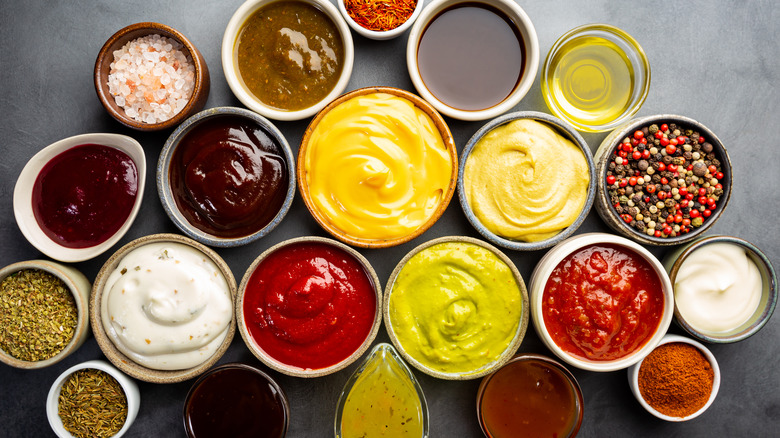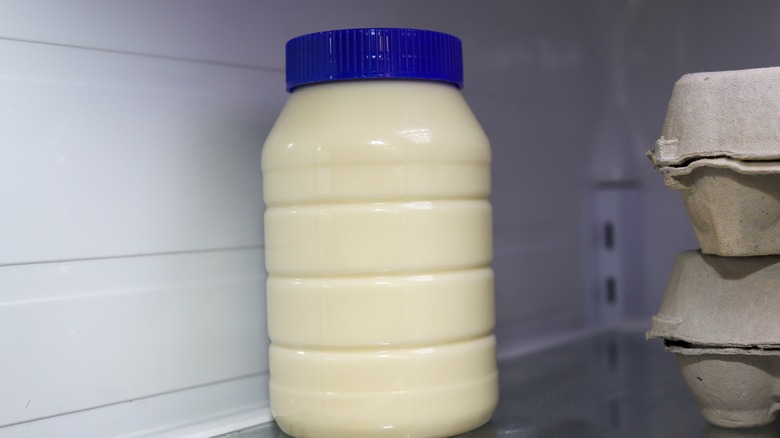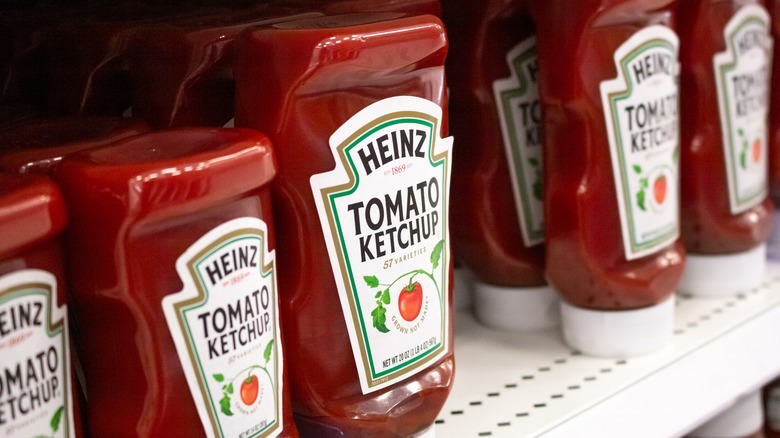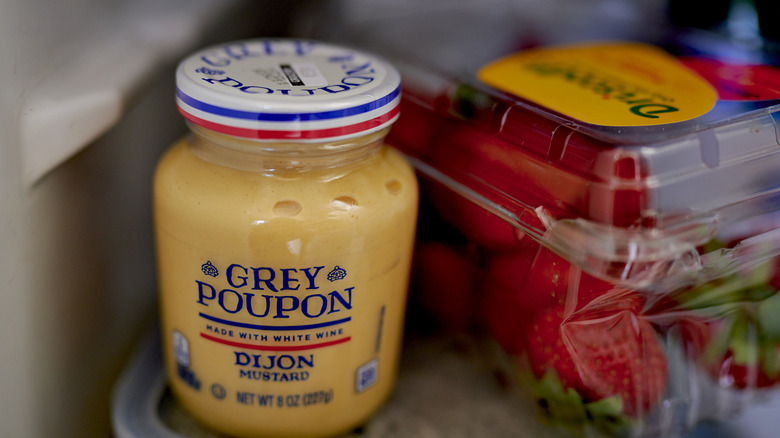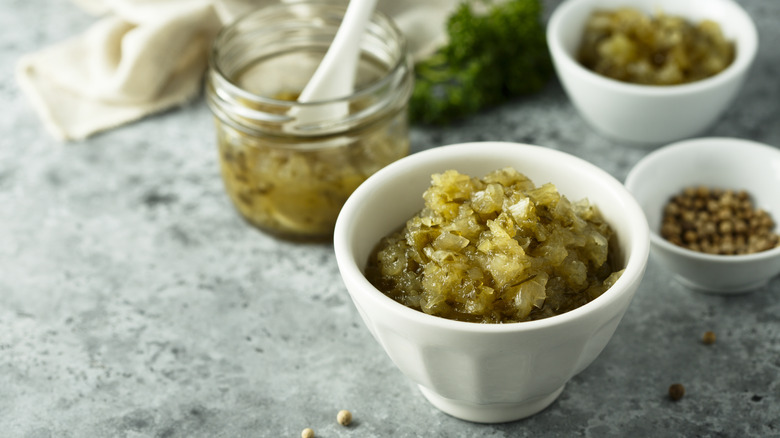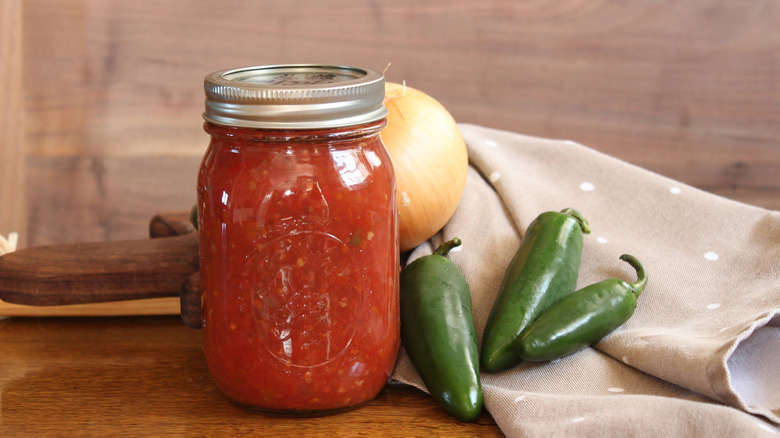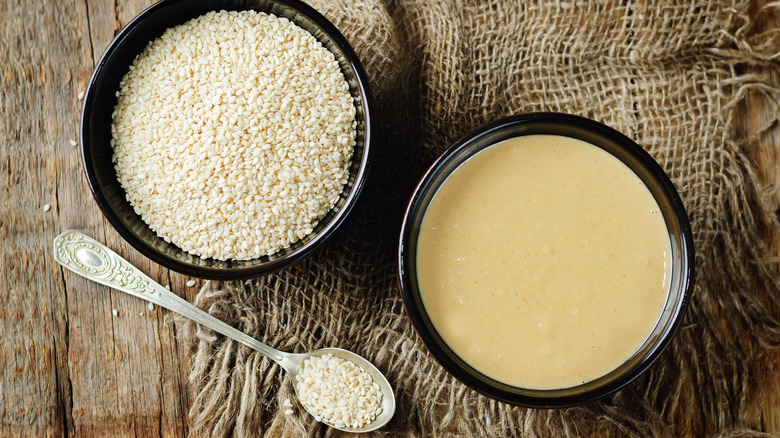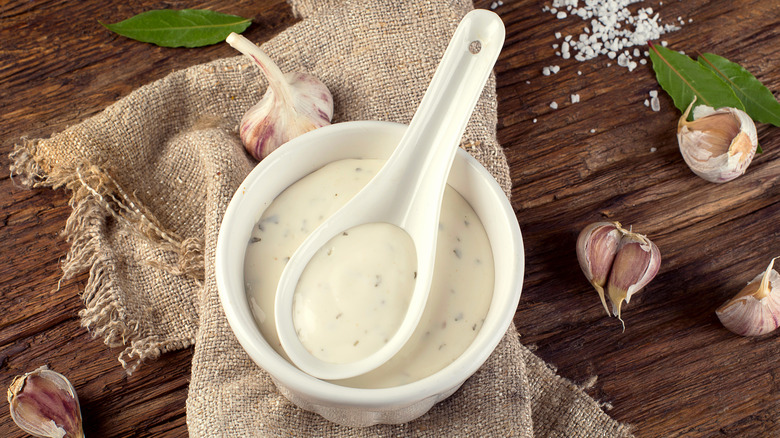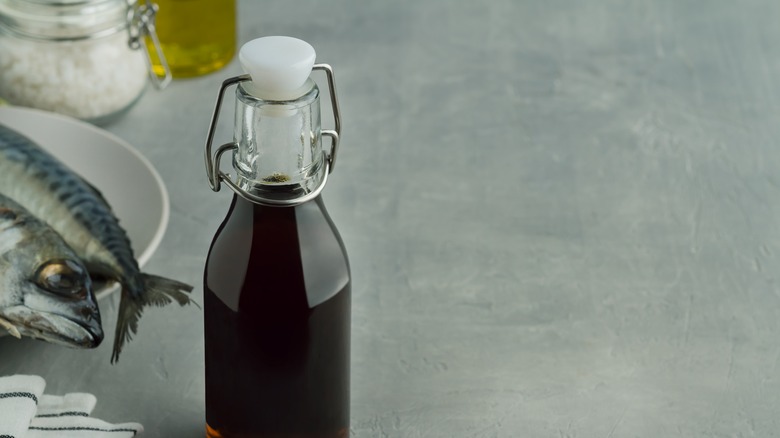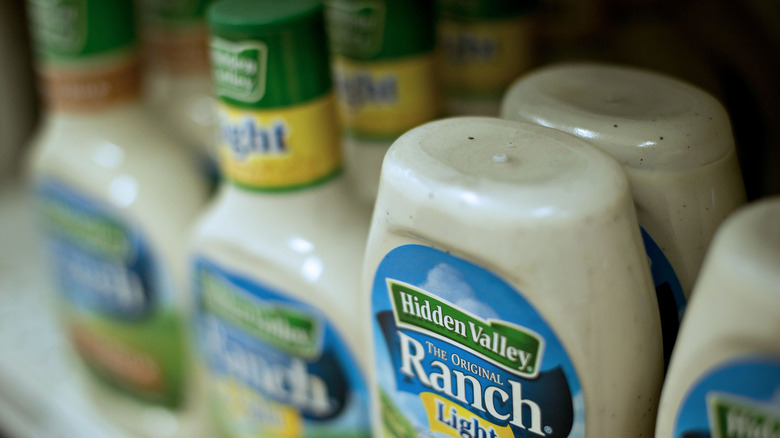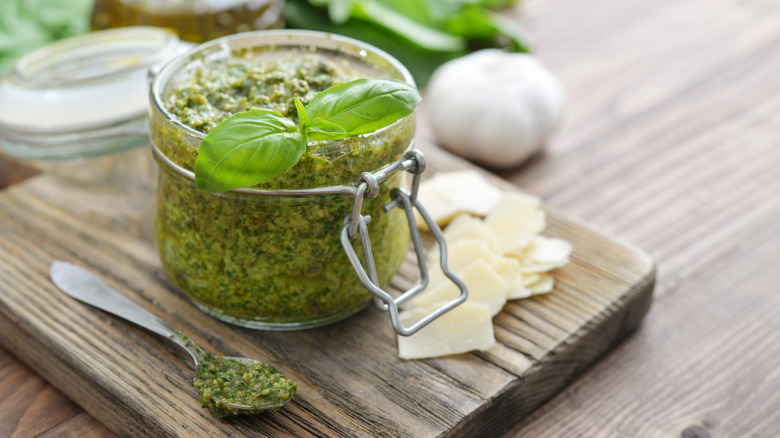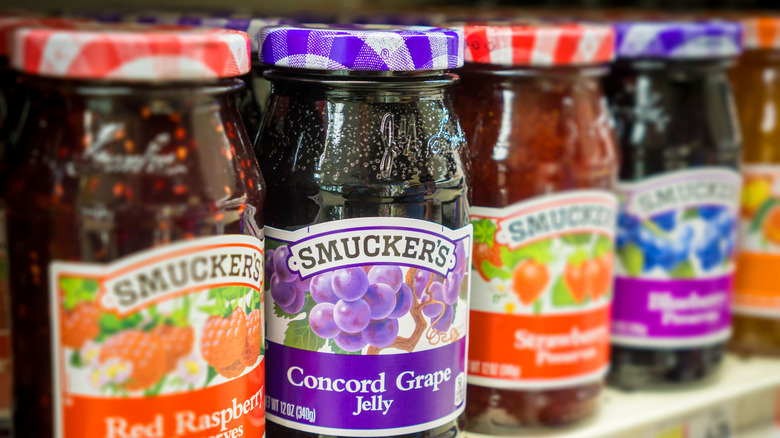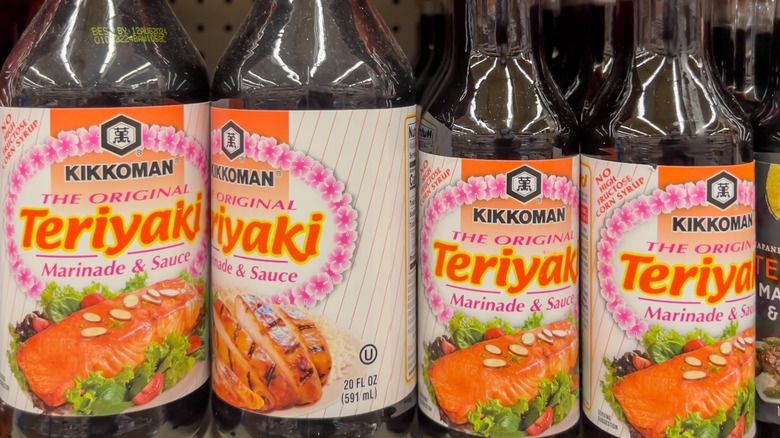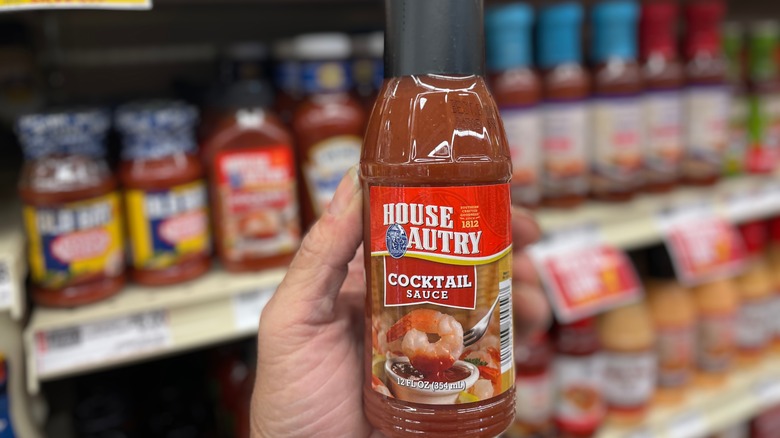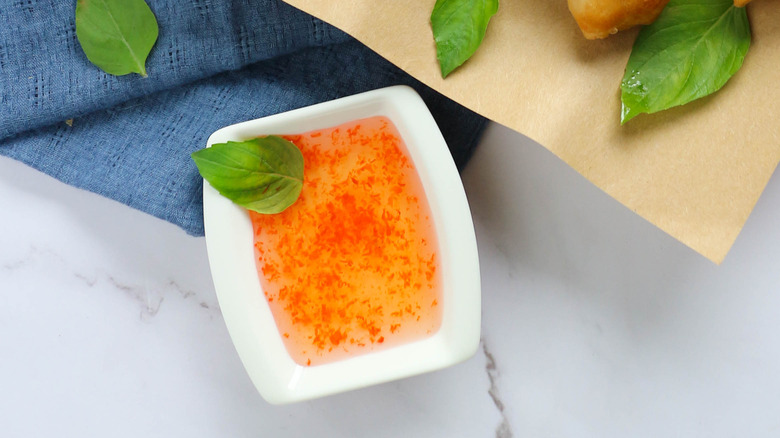14 Condiments That Need To Be Refrigerated
Ketchup and mustard might be the first sauces that come to mind when you envision condiments. Yet, that only scratches the surface of the incredible lineup of condiments that exist. Some aren't even sauces. So, what is a condiment? Is it a spread that you slather onto hoagies, or is it a dip for foods like chicken nuggets? The answer is blurry, but the general consensus is that condiments are paired with foods to enhance them, whether for flavor, texture, or both. They are something that we could certainly live without but probably wouldn't want to because they're the cherry on top, if you will. There are undoubtedly condiments that remain favorites throughout the years and across the world. BBQ sauce, steak sauce, and hot sauce are just a few classics.
Some of these delicious products are safe to store outside the refrigerator, but a surprising amount is not. This might seem confusing since you find many in the same aisle at the supermarket, on a shelf that is nowhere near the refrigerated section. It all comes down to the ingredient makeup. Once the container is no longer airtight, things like mold, yeast, and rancidity become a concern for certain condiments with dairy and other perishable elements. In contrast, others aren't a severe health risk when you leave them in the cabinet, but they undoubtedly taste high-grade for longer when you opt for the fridge. Therefore, you might want to reconsider where you store your condiments. We're here to help!
Mayonnaise
There some is debate over whether or not mayonnaise needs to be refrigerated, and the truth is that it should. When you analyze the labels of various mayo brands, you'll see that some bottles advise the consumer to refrigerate them after you open them. This also applies even for the mayonnaise containers that don't explicitly state that because mayonnaise has eggs as one of its core ingredients. The eggs provide richness to the mayo. They are a major contributor to what makes the condiment creamy, so the extra step of popping it in the refrigerator is worth it.
The temperature in your kitchen likely fluctuates (especially when you cook), so if you leave the jar at room temperature, it might reside in an environment that speeds up its spoilage. Another thing to remember is that mayonnaise lasts only a couple of months after you first use it, so if your household doesn't go through copious amounts of it, purchase a smaller-sized bottle.
Ketchup
What is the deal when it comes to ketchup and its proper storage? Many folks believe the correct way to store it is in the refrigerator. Some people even swear that cold ketchup tastes better than room-temperature ketchup. Yet, ketchup bottles commonly populate restaurant tables or condiment stations when you eat out. Luckily, you no longer need to scratch your head over this query because we have the answer. To maintain the ketchup's taste, you should store it under refrigeration once you break the seal (because, yes, ketchup can go bad just like many other tomato-based products).
So, what is the real reason restaurant ketchup never goes in the fridge, then? It is pretty simple; restaurants go through so much of it so quickly that they don't need to worry about spoilage as you do at home. Their rotation of the product is much quicker than the average household. When you leave a bottle of ketchup in the pantry for long periods after it's been opened, its quality decreases, and it spoils faster.
Dijon mustard
Dijon mustard doesn't necessarily pose any health risks when you store it in the cupboard, however, it is still one of the foods you should put in the fridge right now. Dijon is known for its pronounced taste. The sharp and spicy undertone pairs well with all sorts of ingredients like cheese, meat, and eggs. Not to mention, it is a fantastic addition to salad dressings and a tasty spread for sandwiches.
Unfortunately, the pleasant flavor of dijon mustard soon diminishes when you don't store it properly. After all, if a condiment's purpose is to add value and flavor to your dish, you certainly don't want to have flavorless mustard for your meal. Fortunately, just like many other condiments on this list, you only need to chill it after you open the jar. Its taste remains robust as long as the lid is untouched, so any unopened containers you have in the cupboard are still perfectly fine.
Relish
When you think of relish, you likely think of the sweet pickle relish that you smear on foods like hot dogs, sandwiches, or burgers. Dill relish is good, too. The textural properties of it surely upgrade many meals. Although pickle relish is the most common, there are other types of relish, like zucchini relish or piccalilli, which uses a mix of different vegetables. They all have one thing in common, though. Relish is considered a perishable food. This is the case whether you purchase jars at the store or are adventurous enough to make your own from scratch.
This food lasts for months when you store it in the correct manner under refrigeration. This is why it's important to know how long condiments really last in your fridge because their viability varies depending on the product. For example, store-bought versions of sweet pickle relish last as many as 12 months if correctly stowed. It is assuredly acceptable to have the jar sit out for short periods, though, just not for any sort of long-term storage.
Salsa
Salsa is another condiment that requires a cool environment to stay fresh so that it is safe to consume. When you observe the ingredients, jarred salsa is usually a combination of peppers, tomatoes, and onions (along with spices and other flavorings), which all have a short shelf life, especially once they've been chopped. If you wonder how long you can keep your salsa in the fridge, it all comes down to how it was made.
Just as with many other foods, from-scratch salsa certainly tastes better, but it comes at a price because it spoils much more quickly. For homemade salsa, time is of the essence because you need to eat it up within roughly five days of when you made it. According to Pacific Northwest Extension, you should enjoy commercially made salsa within one or two months of the date that you open the jar. Don't worry if you have a stockpile of salsa in your pantry, though. The sealed jars can safely remain in there for over a year.
Tahini
Tahini is another condiment you need to keep chilled, which might come as a surprise to some. This fact remains true whether you make tahini at home or acquire a commercially produced brand from the grocery store. There are a lot of variations, but a basic tahini is made from just ground sesame seeds and a bit of oil (salt is optional). It is considered both a nut butter and a condiment that complements sweet and savory foods. The risk when you leave tahini (and other types of nut butter) in warm environments is they are susceptible to going rancid. What causes rancidity, you ask? The amount of oil in the product plays a considerable role in this.
As with other types of nut butter, like peanut butter, when you place tahini in the refrigerator, it turns a bit thicker. If you prefer it to be thinner and don't like to eat it cold, this certainly seems like an annoyance. To solve this issue, portion out however much you are about to use and allow it to sit on the counter and come to room temperature before you work with it.
Aioli
Aioli presents itself on this list because it involves egg yolks among its ingredients. If you are unfamiliar with what aioli is, it is a mayo-like sauce that complements meat, seafood, and veggies. People also spread it onto burgers and wraps for flavor and texture upgrades. Traditional aioli is made with mashed garlic, egg yolks, and extra virgin olive oil, but sometimes people take a shortcut by simply adding garlic and flavorings to mayonnaise. Whatever the case, anything that includes minced garlic, mayo, or eggs must be appropriately kept in cold storage so it won't go bad. This also stands for store-bought aioli that contains preservatives.
Furthermore, the aioli you create in the comfort of your own home needs to be chilled and enjoyed within a few short days of when you make it. FoodSafety, which compiles information from several government agencies, reports that once day five comes around for your homemade aioli, the sauce is no longer edible, and you must discard it. So, although aioli is a top-tier companion for endless foods, be sure to make it when you know you'll savor it and won't have any leftovers that end up in the trash.
Fish sauce
Since fish sauce comes from fermented fish and salt, it often finds its way into cupboards along with dry goods and other shelf-stable sauces. Yet, you might want to think twice before you place it there. After you open fish sauce for the first time, gas begins to develop inside the container. Room-temperature air has the ability to affect the amount of gas released from the bottle. Fish sauce can get even worse if you store it in a cabinet near the stovetop where the temperature in the area often increases.
And if you are unaware, that gas certainly has a fishy odor, which is why you should avoid storing fish sauce in your pantry. So, unless you want your other food items to have a lingering unpleasant aroma, it is better to be safe than sorry. Moreover, when you move fish sauce to the cooler, you instantly double the time this condiment stays fresh. So, there is all the more reason to do so.
Ranch dressing
Whether homemade or store-bought, ranch dressing contains ingredients that, without a doubt, require refrigeration. Do you know precisely what this tasty dressing consists of? Although ranch is a classic, it's easy to enjoy without wondering what its exact composition is. This ranch dressing guide sets the record straight. The main culprits that make the dressing susceptible to spoilage are buttermilk and mayonnaise. They have the potential to make you sick if you consume them once they have been left out in a warm environment for too long. Aside from those components, seasonings give the ranch dressing mixture its nostalgic and famous taste.
The USDA's Food Safety and Inspection Service states that you must discard opened bottles of any cream-based dressings if they've been at room temperature for more than a couple of hours. Yes, unfortunately, ranch dressing falls into that category. Ultimately, take good care of your dressing by storing it in the refrigerator in order to continue dipping chicken wings and pizza slices into it without any trouble whatsoever.
Pesto
What's not to love about pesto, which has hints of pine nuts, basil, parmesan, garlic, and oil? It is a versatile sauce since it tastes just as phenomenal in warm dishes as it does in cold foods. When you examine its ingredients, though, it's easy to see why you need to pop this condiment in the fridge if you have any extra. You must store fresh herbs in cold environments; parmesan cheese is another case in point here. Even vegan pesto that excludes cheese requires refrigeration because of the basil.
You need to use commercially made pesto within a week of when you first opened the jar, and you should observe its appearance and smell before you work with it again. For homemade pesto, you are in even more of a time crunch to use it. Provided that you prefer pesto to be room temperature or warm, microwave it in short intervals to increase its temperature before use. If you have trouble using up pesto before it goes bad, try to purchase it in smaller quantities.
Jam
Although jams and jellies have a considerable amount of sugar, they sadly don't last for ages like honey does; this is because the fruit makes up most of its structure. When you buy jam from the store, there is an array of unrefrigerated jars to choose from. So, when do you need to transfer jams and jellies to the refrigerator? You ought to keep them in the cooler once you unseal them because that's when the clock starts to tick on their shelf life. Over time, these fruit spreads become more vulnerable to fungi growth if they're not stored properly.
Yep, you read that right. Mold and yeast are known to invade jams and jellies. Remember to use a clean utensil every time you dip into the jelly and ensure you tightly screw the lid back on between each use; this helps protect it so it doesn't spoil prematurely. When you practice these habits, the jam products will last for several months in the refrigerator.
Teriyaki sauce
Believe it or not, teriyaki sauce is not exempt from this list of refrigerated condiments simply because soy sauce is its main ingredient. We all know soy sauce does not necessarily require refrigeration, but teriyaki sauce as well as teriyaki marinade have additional ingredients like onion and garlic. Additionally, honey and ginger commonly play a part in the sauce's distinct taste. According to Today, your best bet is to store teriyaki sauce in a chilled environment for the sake of its quality.
If you have an opened bottle of teriyaki sauce in your cabinet right now, you need not fear; it is still safe to consume. Having said that, you might as well take advantage of your refrigerator because it benefits the product in the long run. It would be a shame to drizzle your food with teriyaki sauce only to find its flawless blend of sweet, sour, and salty flavors have dwindled and become insipid because of improper storage.
Cocktail sauce
Cocktail sauce is another one you shouldn't leave out on the counter or in the cupboard for quality reasons. People often enjoy this sauce with an array of seafood, but you might associate it more with shrimp because of the well-known dish shrimp cocktail. It also is a fantastic substitute for ketchup when you run out of that staple while you are in the midst of making a recipe. At its simplest, cocktail sauce is comprised of ketchup (or chili sauce), horseradish, and seasonings. There are other variations to which folks add a splash of Worcestershire or hot pepper sauce to give it more depth.
Regardless of which version you enjoy, the USDA suggests you store cocktail sauce in the fridge for up to half a year, but not any longer. If this is a sauce you use sparingly, make a single serving from scratch. That way, you just have the amount you need, and you cut down on any undesired food waste.
Duck sauce
For those who don't know what duck sauce is and what you eat it with, this is a fruity yet slightly tangy orange-hued sauce that originated in America and commonly accompanies Chinese food. People enjoy it on everything from fried appetizers and chicken to pork and duck (though duck is not among its ingredients). If a food establishment is providing duck sauce, you might receive it in small packets similar to ketchup packets. The tiny packets don't need to be refrigerated because they are sealed airtight. Plus, they're such a small portion that most people use them all up in one go.
On the other hand, if you purchase this sauce at the store, you'll want to stick the bottles in the refrigerator once they've been opened. Kikkoman reports you need to keep duck sauce at a controlled temperature for quality and food safety since it contains fruit, specifically plums. Once opened, you should use it within a few weeks for optimal flavor. Of course, every duck sauce brand is different, and other brands might last longer, so use your discretion.
